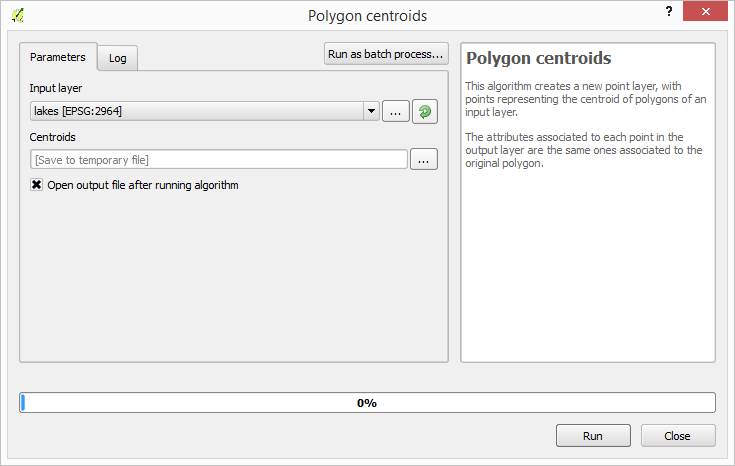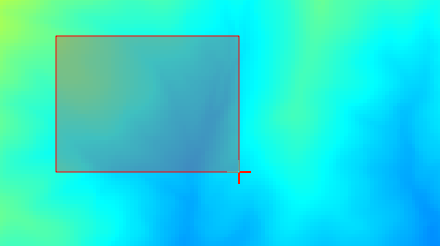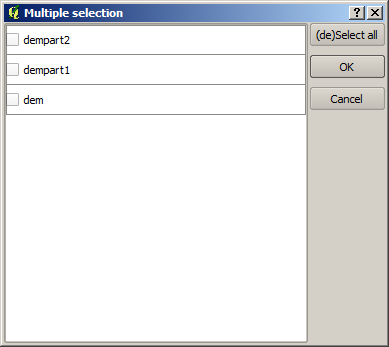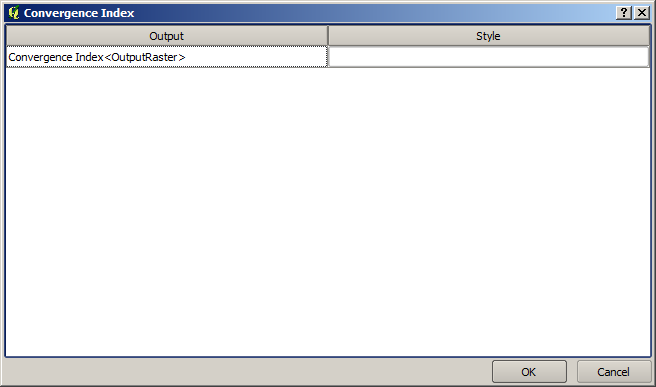Instrumentarul¶
Bara de instrumente este elementul principal al GUI-ului de prelucrare, fiind cel cu care aveți cele mai multe șanse de a vă întâlni în munca de zi cu zi. Acesta prezintă lista, grupată în diferite blocuri, a tuturor algoritmilor disponibilii, fiind punctul de acces pentru rularea lor, fie ca proces individual, fie ca proces aparținând unei serii, care implică mai multe execuții ale aceluiași algoritm utilizând diferite seturi de intrare.
Figure Processing 5:

Bara instrumentelor de procesare
Setul de instrumente conține toți algoritmii disponibili, împărțiți în așa-numiții “Furnizori”.
Providers can be (de)activated in the settings dialog. A label in the bottom part of the toolbox will remind you of that whenever there are inactive providers. Use the link in the label to open the settings window and set up providers. We will discuss the settings dialog later in this manual.
By default only, providers that do not rely on third-party applications (that is, those that only require QGIS elements to be run) are active. ALgorithms requiring external applications might need additional configuration. Configuring providers is explained in a later chapter in this manual.
În partea de sus a setului de instrumente, veți găsi o casetă de text. Pentru a reduce numărul de algoritmi prezentați în caseta de instrumente și pentru a găsi mai ușor unul de care aveți nevoie, puteți introduce orice cuvânt sau o expresie în caseta de text. Observați că, pe măsură ce tastați, numărul de algoritmi din setul de instrumente se reduce doar la acei algoritmi care conțin în numele lor textul pe care l-ați introdus.
Dacă există algoritmi care se potrivesc căutării dvs., dar aparțin unui furnizor care nu este activ, o etichetă suplimentară va fi afișată în partea de jos a bării de instrumente.
Figure Processing 6:

Processing Toolbox showing search results
If you click on the link in that label, the list of algorithms will also include those from inactive providers, which will be shown in light gray. A link to active each inactive provider is also shown.
Figure Processing 7:

Processing Toolbox showing search results
Pentru a executa un algoritm, este suficient să faceți dublu-clic pe numele său, în bara de instrumente.
Dialogul algoritmului¶
După ce faceți dublu-clic pe numele algoritmului pe care doriți să îl executați, este afișat un dialog similar cu cel din figura de mai jos (în acest caz, dialogul corespunde algoritmului ‘Centroizii poligonului’).
Figure Processing 8:

Dialogul Parametrilor
Acest dialog este utilizat pentru a seta valorile de intrare pe care algoritmul trebuie să le execute. Vi se prezintă un tabel în care trebuie setate valorile de intrare și parametrii de configurare. Conținutul va fi diferit, desigur, în funcție de cerințele algoritmului care urmează să fie executat, creându-se automat pe baza acestor cerințe.
Deși numărul și tipul de parametri depind de caracteristicile algoritmului, structura este similară pentru toate. Parametrii din tabel pot avea unul din tipurile de mai jos.
Un strat raster, selectabil dintr-o listă a tuturor straturilor disponibile (deschise în mod curent), în QGIS. Selectorul conține și un buton în partea sa dreaptă, permițând selectarea numelor corespunzătoare straturilor neîncărcate, în mod curent, în QGIS.
Un strat vectorial, selectabil dintr-o listă a tuturor straturilor vectoriale disponibile în QGIS. Straturile care nu sunt încărcate în QGIS pot fi selectate, similar straturilor raster, dar numai în cazul în care algoritmul nu necesită selectarea unui câmp din tabelul de atribute al stratului. În acest caz, numai straturile deschise pot fi selectate, astfel încât să se poată prelua lista de nume a câmpurilor disponibile.
Veți vedea un buton pentru fiecare selector de strat vectorial, așa cum se arată în figura de mai jos.
Figure Processing 9:

Butonul de iterare vectorială
În cazul în care algoritmul conține mai mulți, se va putea alege doar unul. Dacă este apăsat butonul corespunzător unei intrări vectoriale, algoritmul va fi executat iterativ pentru fiecare dintre entitățile sale, în loc de o singură dată pentru întregul strat, generându-se un număr de rezultate identic cu numărul de execuții ale algoritmului. Acest lucru permite automatizarea procesului, atunci când toate entitățile dintr-un strat trebuie să fie procesate separat.
O tabelă, selectabilă dintr-o listă a tuturor tabelelor disponibile în QGIS. Tabelele non-spațiale sunt încărcate în QGIS sub formă de straturi vectoriale, fiind tratate ca atare de către program. În mod curent, lista tabelelor disponibile, pe care o vedeți atunci când execută un algoritm, este limitată la tabele care provin din fișiere având formatul dBase (
.dbf) sau Valori Separate prin Virgulă (.csv).Opțiunea de a alege dintr-o listă de selecție a variantelor posibile.
O valoare numerică, care urmează să fie introdusă într-o casetă de text. Veți găsi un buton alături de casetă. Efectuând clic pe el se va deschide un dialog care permite introducerea unei expresii matematice, transformându-se într-un calculator foarte util. În expresie pot fi adăugate anumite variabile utile, legate de datele încărcate în QGIS, astfel încât să puteți selecta o valoare derivată din oricare dintre aceste variabile, cum ar fi dimensiunea celulei dintr-un strat sau coordonata nordică a altuia.
Figure Processing 10:

Selectorul de Numere
Un interval, cu valori min și max care vor fi introduse în două casete de text.
Un șir, care urmează să fie introdus într-o casetă de text.
Un câmp, de ales din tabelul atribute al unui strat vectorial, sau un singur tabel selectat dintr-un alt parametru.
Un sistem de coordonate de referință. Aveți posibilitatea să tastați codul EPSG direct în caseta de text, sau să-l selectați din dialogul de selecție a CRS-ului, care apare atunci când faceți clic pe butonul din partea dreaptă.
An extent, to be entered by four numbers representing its
xmin,xmax,ymin,ymaxlimits. Clicking on the button on the right-hand side of the value selector, a pop-up menu will appear, giving you two options: to select the value from a layer or the current canvas extent, or to define it by dragging directly onto the map canvas.Figure Processing 11

Selectorul Extinderii
Dacă selectați prima opțiune, veți vedea o fereastră similară cu cea următoare.
Figure Processing 12

Lista Extinderilor
Dacă o selectați pe a doua, fereastra parametrilor se va ascunde, astfel încât să puteți faceți clic pe ea și să o trageți pe pânză. După ce ați definit dreptunghiul selectat, dialogul va reapărea, având valorile în caseta de text a extinderii.
Figure Processing 13:

Glisare Extindere
A list of elements (whether raster layers, vector layers or tables), to select from the list of such layers available in QGIS. To make the selection, click on the small button on the left side of the corresponding row to see a dialog like the following one.
Figure Processing 14:

Selecție Multiplă
Un mic tabel care va fi editat de către utilizator. Acesta este folosit pentru a defini parametri, cum ar fi tabele de căutare sau nucleele de convoluție, printre altele.
Faceți clic pe butonul din partea dreapta pentru a vedea tabelul și pentru a-i edita valorile.
Figure Processing 15:

Tabelă Reparată
În funcție de algoritm, numărul de rânduri poate fi modificat sau nu, cu ajutorul butoanelor din pe partea dreaptă a ferestrei.
Along with the parameters tab, you will find another tab named ‘Log’. Information provided by the algorithm during its execution is written in this tab, and allow you to track the execution and be aware and have more details about the algorithm as it runs. Notice that not all algorithms write information to this tab, and many of them might run silently without producing any output other than the final files.
On the right hand side of the dialog you wil find a short description of the algorithm, which will help you understand its purpose and its basic ideas. If such a description is not available, the description panel will not be shown.
Some algorithms might have a more detailed help file, which might include description of every parameter it uses, or examples. In that case, you will find a Help tab in the parameters dialog.
O notă privind proiecțiile¶
Algorithms that are run from the processing framework — this is also true of most of the external applications whose algorithms are exposed through it— do not perform any reprojection on input layers and assume that all of them are already in a common coordinate system and ready to be analyzed. Whenever you use more than one layer as input to an algorithm, whether vector or raster, it is up to you to make sure that they are all in the same coordinate system.
Note that, due to QGIS’s on-the-fly reprojecting capabilities, although two layers might seem to overlap and match, that might not be true if their original coordinates are used without reprojecting them onto a common coordinate system. That reprojection should be done manually, and then the resulting files should be used as input to the algorithm. Also, note that the reprojection process can be performed with the algorithms that are available in the processing framework itself.
By default, the parameters dialog will show a description of the CRS of each layer along with its name, making it easy to select layers that share the same CRS to be used as input layers. If you do not want to see this additional information, you can disable this functionality in the Processing settings dialog, unchecking the Show CRS option.
Dacă încercați să executați un algoritm folosind ca intrare două sau mai multe straturi, cu CRS-uri nepotrivite, va fi afișat un dialog de avertizare.
Puteți încă să executați algoritmul, dar fiți conștienți de faptul că, în cele mai multe cazuri se vor produce rezultate greșite, cum ar fi straturile goale datorate straturilor de intrare care nu se suprapun.
Obiecte de date generate de algoritmi¶
Obiectele de date generate de un algoritm pot fi oricare din următoarele tipuri:
Un strat raster
Un strat vectorial
O tabelă
Un fișier HTML (folosit pentru ieșiri de text și grafice)
These are all saved to disk, and the parameters table will contain a text box corresponding to each one of these outputs, where you can type the output channel to use for saving it. An output channel contains the information needed to save the resulting object somewhere. In the most usual case, you will save it to a file, but in the case of vector layers, and when they are generated by native algorithms (algorithms not using external applications) you can also save to a PostGIS or Spatialite database, or a memory layer.
To select an output channel, just click on the button on the right side of the text box, and you will see a small context menu with the available options.
In the most usual case, you will select saving to a file. If you select that option, you will be prompted with a save file dialog, where you can select the desired file path. Supported file extensions are shown in the file format selector of the dialog, depending on the kind of output and the algorithm.
The format of the output is defined by the filename extension. The supported
formats depend on what is supported by the algorithm itself. To select a format,
just select the corresponding file extension (or add it, if you are directly typing
the file path instead). If the extension of the file path you entered does not
match any of the supported formats, a default extension will be
appended to the file path, and the file format corresponding to that extension will
be used to save the layer or table. Default extensions are .dbf for
tables, .tif for raster layers and .shp for vector layers. These
can be modified in the setting dialog, selecting any other of the formats supported by QGIS.
If you do not enter any filename in the output text box (or select the corresponding option in the context menu), the result will be saved as a temporary file in the corresponding default file format, and it will be deleted once you exit QGIS (take care with that, in case you save your project and it contains temporary layers).
You can set a default folder for output data objects. Go to the settings
dialog (you can open it from the Processing menu), and in the
General group, you will find a parameter named Output folder.
This output folder is used as the default path in case you type just a filename
with no path (i.e., myfile.shp) when executing an algorithm.
When running an algorithm that uses a vector layer in iterative mode, the entered file path is used as the base path for all generated files, which are named using the base name and appending a number representing the index of the iteration. The file extension (and format) is used for all such generated files.
Apart from raster layers and tables, algorithms also generate graphics and text as HTML files. These results are shown at the end of the algorithm execution in a new dialog. This dialog will keep the results produced by any algorithm during the current session, and can be shown at any time by selecting Processing ‣ Results viewer from the QGIS main menu.
Some external applications might have files (with no particular extension restrictions) as output, but they do not belong to any of the categories above. Those output files will not be processed by QGIS (opened or included into the current QGIS project), since most of the time they correspond to file formats or elements not supported by QGIS. This is, for instance, the case with LAS files used for LiDAR data. The files get created, but you won’t see anything new in your QGIS working session.
Pentru toate celelalte tipuri de rezultate, veți găsi o casetă de selectare, pe care o puteți folosi pentru a indica algoritmului dacă să încarce fișierul după ce este generat de către algoritm, sau nu. În mod implicit, toate fișierele vor fi deschise.
Optional outputs are not supported. That is, all outputs are created. However, you can uncheck the corresponding checkbox if you are not interested in a given output, which essentially makes it behave like an optional output (in other words, the layer is created anyway, but if you leave the text box empty, it will be saved to a temporary file and deleted once you exit QGIS).
Configurarea cadrului de procesare¶
După cum s-a menționat, meniul de configurare oferă acces la un nou dialog în care puteți configura modul în care funcționează algoritmii. Parametrii de configurare sunt structurați în blocuri separate pe care le puteți selecta în partea stângă a dialogului.
Împreună cu intrarea Output folder, mai sus menționată, blocul General conține parametri pentru stabilirea stilului de randare prestabilit pentru straturile de ieșire (care sunt straturi generate prin utilizarea algoritmilor oricăruia dintre componentele GUI). Doar creați stilul pe care doriți să-l folosiți în QGIS, salvați-l într-un fișier, apoi introduceți calea către acest fișier în setări, astfel încât algoritmii să-l poată folosi. Ori de câte ori un strat va fi încărcat prin SEXTANTE, iar apoi va fi adăugat la canevasul QGIS, el va fi randat cu acest stil.
Stilurile de randare pot fi configurate în mod individual pentru fiecare algoritm și pentru fiecare dintre rezultatele sale. Doar faceți clic dreapta pe numele algoritmului din caseta de instrumente și selectați Edit rendering styles. Veți vedea un dialog similar cu cel care urmează.
Figure Processing 16:

Stiluri de Randare
Selectați fișierul de stil (.qml), pe care îl doriți pentru fiecare ieșire, apoi apăsați [OK].
Alți parametri de configurare din grupul General sunt listați mai jos:
- Use filename as layer name. The name of each resulting layer created by an algorithm is defined by the algorithm itself. In some cases, a fixed name might be used, meaning that the same output name will be used, no matter which input layer is used. In other cases, the name might depend on the name of the input layer or some of the parameters used to run the algorithm. If this checkbox is checked, the name will be taken from the output filename instead. Notice that, if the output is saved to a temporary file, the filename of this temporary file is usually a long and meaningless one intended to avoid collision with other already existing filenames.
- Keep dialog open after running algorithm. Once an algorithm has finished execution and its output layers are loaded into the QGIS project, the algorithm dialog is closed. If you want to keep it open (to run the algorithm again with different parameters, or to better check the output that is written to the log tab), check this option
- Use only selected features. If this option is selected, whenever a vector layer is used as input for an algorithm, only its selected features will be used. If the layer has no selected features, all features will be used.
- Pre-execution script file and Post-execution script file. These parameters refer to scripts written using the processing scripting functionality, and are explained in the section covering scripting and the console.
Apart from the General block in the settings dialog, you will also find a block for algorithm providers. Each entry in this block contains an Activate item that you can use to make algorithms appear or not in the toolbox. Also, some algorithm providers have their own configuration items, which we will explain later when covering particular algorithm providers.